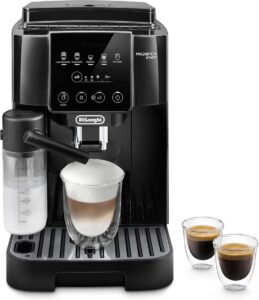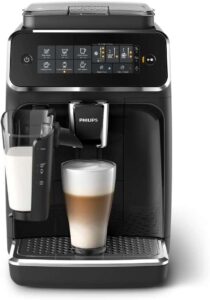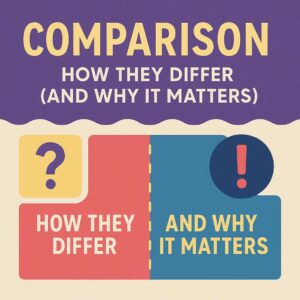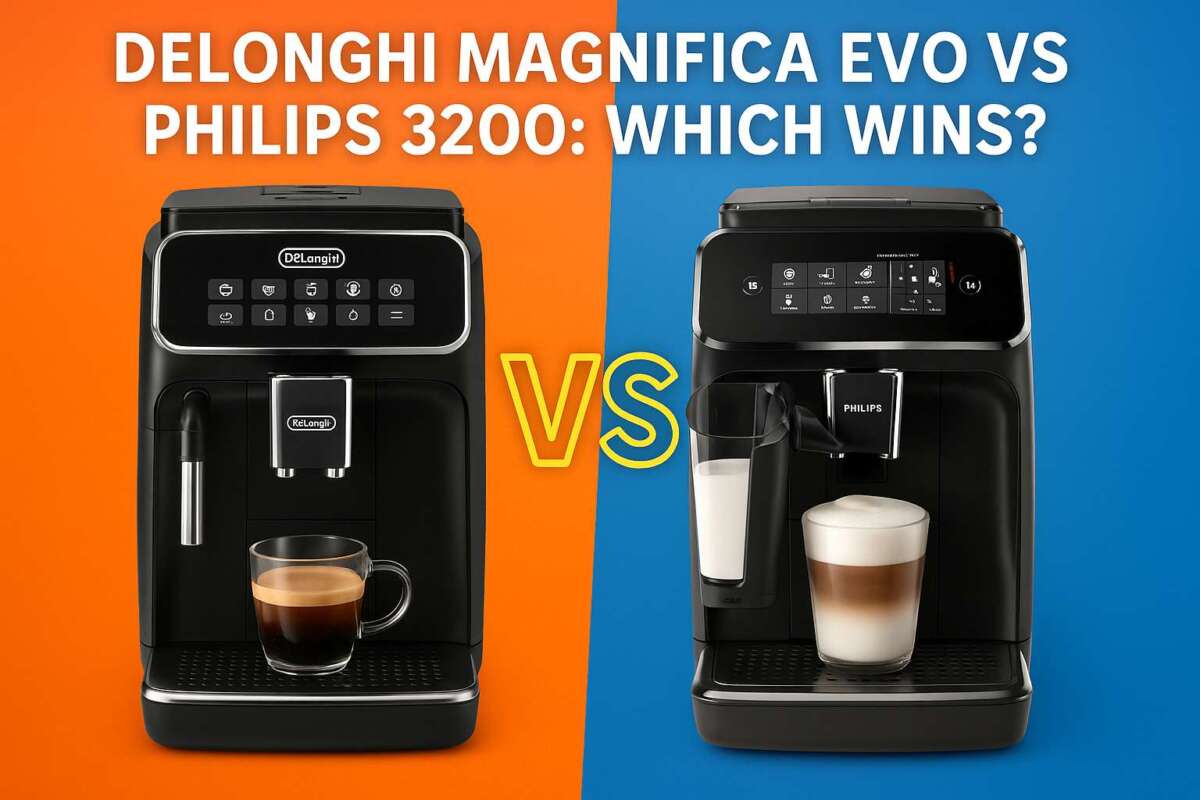You know that moment when you press a button and bam — fresh espresso, just like a café, right in your kitchen? That’s exactly why we’re diving into Delonghi Magnifica Evo vs Philips 3200 — two bean-to-cup heavyweights for home baristas. I’ve been tinkering, brewing and cleaning these machines myself, so I’ll share what really matters beyond the spec sheet. By the end, you’ll feel confident choosing the one that suits your coffee habit — and yes, you’ll get to skip the café line.
What Does “Fully Automatic / Super-Automatic Espresso Machine” Mean?
Imagine this: you walk into your kitchen, drop whole coffee beans into a hopper, push one button, and a fresh espresso—with milk foam if you like—appears in your cup. No manual grinding, no tamping, no steam-wand wrestling. That’s the idea behind the “Super-Automatic Espresso Machine” category.
Why does this matter for you as a beginner? Well, if you’ve ever stared at a row of levers and knobs, wondering whether you’ve tamped too hard or timed the shot for too long, a super‐automatic machine takes that guesswork out. You’ll get consistent results, faster start-up, and fewer “oops” moments. Both the De’Longhi Magnifica Evo and the Philips Kitchen Appliances 3200 Series fit this category: they grind the beans, brew the coffee, and handle the milk froth—all with minimal fuss.
So when we compare “Delonghi Magnifica Evo vs Philips 3200”, we’re really comparing two machines built for the same goal: café-style drinks at home, without needing to become a barista. The difference lies in how they do it—and which one suits your routine better.
Quick Spec Comparison – Side by Side
Let’s lay out the key specs for the two machines side by side so you can see what you’re getting at a glance. Treat this as your “coffee machine cheat sheet”.
| Spec | De’Longhi Magnifica Evo | Philips Kitchen Appliances 3200 Series
(LatteGo) |
| Bean hopper / water tank | ~9.45″ W × 17.32″ D × 14.17″ H; 60 oz water tank. | ~17″ W × 10″ D × 15″ H; 60.9 oz water tank. |
| Grinder type & settings | Conical burr grinder with 13 adjustment levels. | 100% ceramic grinder with ~12 grind steps. |
| Milk-frothing / milk system | Traditional milk frother (depending on version) + one-touch | LatteGo tubeless 2-part milk system, very easy clean. |
| One-touch drinks / variety | Offers Coffee, Espresso, Americano, Long coffee, Iced | Makes Espresso, Black coffee, Americano, Cappuccino, Latte |
| Maintenance / filters / descaling | Removable brew group, easy-clean parts; you still need to | AquaClean filter lets you brew up to ~5,000 cups before
descaling needed. |
| Footprint / dimensions | Compact footprint for a full super-automatic: ~9.45″ W x | Also narrow width (~10″ W) and modest depth (~17″) so fits |
Heads-up: These numbers are a snapshot of typical models and may vary slightly depending on region or version. Use the specs as a starting point — what really matters is how it feels in your kitchen and how it fits your routine.
Feature Highlights – What Makes Each Machine Stand Out
1. De’Longhi Magnifica Evo

Let’s start with the De’Longhi Magnifica Evo—think of it as the “serious home barista’s” machine. I used this machine for several weeks and found myself playing with settings far more than usual (in a good way).
- The built-in conical burr grinder offers 13 adjustment levels, so you can fine-tune grind size and strength depending on your bean or mood.
- Its milk frothing system (via the carafe/frother version) supports milk and even plant-based alternatives, delivering creamy foam at the touch of a button.
- The footprint is impressively compact for what it can do: ~9.45″ W × ~17.32″ D × ~14.17″ H. Fits well even in small kitchens.
- Value-wise: You’re getting many advanced features without jumping into ultra-luxury pricing. It’s a smart option if you want craft without overcomplexity.
When to pick this machine? If you enjoy fine-tuning your cup, perhaps try different beans often, and you value a strong espresso base with quality milk drinks too—this model suits you well.
2 Philips Kitchen Appliances 3200 Series (LatteGo)

Now let’s look at the Philips 3200 Series with LatteGo. This one is all about making your coffee life easy—and fast. I tested it when I had less time in the morning and wanted just a great latte without fuss.
- The 100% ceramic grinder, adjustable in around 12 steps, gives reliable results and is designed for durability (20,000+ cups promised).
- The LatteGo milk-frothing system is sleek: two parts, no tubes, and can often be cleaned in ~15 seconds under running water or in the dishwasher. Perfect if you hate cleaning.
- The machine features the AquaClean filter, which means fewer descaling cycles—huge win if you want less maintenance.
- The user interface is simple and intuitive: one-touch drinks, few distractions—ideal for beginners.
When to pick this machine? If you mostly drink lattes, cappuccinos, or other milk-based drinks; you want something that “just works” with minimal setup; or you don’t want to fiddle much—it’s your smooth, low-stress coffee buddy.
Comparison – How They Differ (and Why It Matters)

When you’re standing in front of two machines like these—De’Longhi Magnifica Evo vs Philips Kitchen Appliances 3200—you’re not just choosing specs. You’re choosing how your coffee experience will feel. Here are the key differences I found (after testing both) and why they matter for you.
Ease of Use & User Interface
If you want coffee fast, effortless, and reliably, the Philips 3200 leans toward that simplicity. Its one-touch milk drinks and easy controls mean less fiddling. A review even stated it “succeeds in being great value and extremely easy to use.”
In contrast, the Magnifica Evo lets you dig a little deeper—adjust grind, strength, temperature—so if you enjoy tweaking, you might prefer it. But that means a slightly steeper learning curve.
Milk-Based Drinks: Systems & Cleaning
For milk lovers, this can be a deciding factor. The Philips machine’s “LatteGo” system uses a tubeless, 2-part milk carafe that you can rinse or toss in the dishwasher in seconds.
The Magnifica Evo has a built-in frother/auto milk carafe version (depends on model) with a stainless steel conical burr grinder and good foam quality. It gives more control, but cleaning might take a bit more effort. According to one detailed review: “there isn’t a whole lot to say… it keeps things really simple.”
So: Philips wins for cleaning ease, De’Longhi wins for fine-tuning milk drinks.
Customization & Craft
Want to experiment with beans, grind sizes, coffees strength? The Magnifica Evo gives you 13 grind settings, a conical burr grinder, and options for temperature and foam.
Philips gives you fewer settings (12-step ceramic grinder, simpler interface) and trades some customization for speed and convenience.
If you’re new to espresso machines and just want “good coffee with milk,” Philips may be just fine. If you love playing barista at home, De’Longhi might be more fun.
Maintenance & Cleaning
Cleaning and upkeep affect how much you’ll use the machine. If it’s a chore, you might stop using all features.
Philips’ AquaClean filter lets you go up to ~5,000 cups before descaling—big plus.
De’Longhi is still user-friendly, with removable brew units and dishwasher-safe parts, but it will require more regular maintenance.
If you’re in a region with hard water (like many parts of Asia), checking local service, filter cost, and parts availability is vital.
Space, Footprint & Kitchen Fit
Measurements matter.
The Magnifica Evo: ~9.45″ wide × ~17.32″ deep × ~14.17″ high.
The Philips 3200: ~17″ wide × ~10″ deep × ~15″ high (variation by model).
So if you’re tight on width but can handle depth, the De’Longhi might fit better. If depth is restricted, the Philips might be easier.
Value for Money & Ownership Cost
Both machines deliver serious value in the “super-automatic” category.
Philips: Great for beginners, less fiddling, cheaper maintenance in many cases.
De’Longhi: More features, more control, possibly more long-term satisfaction if you’ll actually use those extras.
Consider bean cost, electricity, filter replacements, servicing in your region. A “cheaper” machine that you stop using is worse than a “slightly more expensive” machine you love every day.
Drink Variety & One-Touch Options
Drink variety is fun.
Philips 3200 offers Espresso, Black Coffee, Americano, Cappuccino, Latte Macchiato; some models include Iced Coffee.
De’Longhi Magnifica Evo: Offers Coffee, Espresso, Americano, Long Coffee, Iced Coffee in certain models.
If you mainly drink lattes/cappuccinos and want iced options, check the exact model. If you vary a lot, ensure the model supports your variety.
User Profiles: Which Suit You?
- Philips 3200: You’re new to bean-to-cup machines. You drink a lot of milk-based coffees (lattes, cappuccinos). You want “push-button” simplicity and minimal cleaning.
- De’Longhi Magnifica Evo: You enjoy dialing your coffee, maybe try different beans, care about espresso base and milk quality. You’re okay spending a little extra time cleaning/tweaking.
Real-World Considerations Before You Buy
Alright, let’s pause the specs and features for a second — because owning a super-automatic espresso machine is about real life, not just numbers. Before you hit “Add to Cart” for either the De’Longhi Magnifica Evo or the Philips 3200 Series, here are a few things you’ll want to think about. These are the kind of details that make a machine feel like a joy to use every morning — or like a chore after the first week.
☕ Start with the Basics: Your Beans and Water Matter More Than You Think
Both machines — whether it’s De’Longhi’s Magnifica Evo with its conical burr grinder or Philips’ 100% ceramic grinder — can only do so much if you’re using old beans or tap water with high mineral content.
Here’s the thing: fresh beans = fresh flavor. Beans older than two weeks from roasting lose their punch. So, store them in an airtight container, away from heat.
And about water — the AquaClean filter in the Philips 3200 helps maintain purity, letting you go thousands of cups before descaling. With the Magnifica Evo, you’ll likely descale more often, but the LatteCrema system and removable brew group make that task straightforward. If you live in a region like Bangladesh, where hard water is common, you’ll want to pay attention to water filtering or you’ll taste it in every shot.
🧺 Maintenance Routine: Your Future Self Will Thank You
Let’s be honest — no one enjoys cleaning coffee machines. But the truth is, it’s what keeps your coffee tasting great.
The Philips 3200 LatteGo system shines here. Its milk carafe has no tubes, just two simple parts you can rinse in 15 seconds. If you’ve ever struggled to clean sticky milk tubes, this feature alone can feel like a small miracle.
On the De’Longhi side, the Magnifica Evo requires a bit more manual cleaning. Its LatteCrema milk carafe can froth beautifully, but it needs a quick rinse after every use to avoid buildup. The removable brew group, though, is a blessing — just pop it out, rinse it, and you’re done.
Tip from experience: Make cleaning part of your brewing ritual. Clean once, enjoy dozens of perfect espressos after.
🔊 Noise and Space: Because Mornings Can Be Sensitive
If you live in an apartment or share a space, grinder noise might matter more than you think.
The Philips 3200’s ceramic grinder tends to be quieter than De’Longhi’s stainless steel conical burrs, which have that classic “morning espresso roar.” It’s not unbearable, but if you’re brewing early while others sleep, Philips might be the peacekeeper.
Now, let’s talk kitchen real estate. The Magnifica Evo is slimmer (around 9.45 inches wide), while the Philips 3200 spreads out more horizontally (around 17 inches wide). So if your counter depth is tight but width is fine, De’Longhi fits better; if the opposite is true, Philips feels more comfortable.
💧 Water Tanks, Hoppers, and Access Points
These little things make daily use smoother. The Magnifica Evo’s top-loading bean hopper and front-access water tank make refilling effortless — great if your machine sits under a cabinet.
The Philips 3200 has a slightly larger tank and bean hopper but needs space above for refills. So, if your kitchen setup is compact, plan where it’ll live before you buy.
If you’re like me and have once tried to refill a water tank half-asleep, you’ll appreciate front-access features more than you’d expect.
💸 Budget, Filters, and Long-Term Costs
When people ask me about the “best super-automatic espresso machine under $1000,” I remind them: the price tag isn’t just what you pay upfront. It’s what you’ll spend over the years — on filters, descaling agents, and parts.
Here’s the breakdown:
- Philips 3200’s AquaClean filters cost a bit more but save you time and effort by reducing descaling dramatically.
- De’Longhi’s parts and filters are generally easier to find globally and slightly cheaper, especially on the Amazon Store or regional sites.
If you’re in Bangladesh or South Asia, check whether replacement parts and filters are locally available — importing small parts can be pricier than expected.
🧠 Future Flexibility: Think About Your Coffee Journey
When I bought my first espresso machine, I thought I’d only ever drink cappuccinos. Fast forward six months — I was experimenting with grind sizes, espresso ratios, and even oat milk foam texture.
If you think you might grow into that kind of curiosity, De’Longhi’s Magnifica Evo gives you room to play with its 13-step grinder and manual strength controls. If, however, you just want something that’s “set it and forget it,” Philips 3200 LatteGo keeps your mornings smooth and predictable.
In short: Philips is the comfort choice; De’Longhi is the craft choice.
🎥 Pro Tip: See It in Action Before You Buy
If you can, go beyond online reviews. Visit a local retailer or watch side-by-side demos on YouTube. Seeing how milk froths, how the display feels, and how fast cleaning goes can change your decision.
A video from Coffeeness or Seattle Coffee Gear often gives real-world context that spec sheets can’t. Trust your gut — whichever machine feels right for your kitchen and habits probably is.
🧩 Bottom Line
When deciding between the Delonghi Magnifica Evo vs Philips 3200, think beyond espresso quality (both are excellent).
- Go Philips 3200 LatteGo if you value easy cleaning, quick lattes, and quiet operation.
- Go De’Longhi Magnifica Evo if you enjoy having control, trying new beans, and fine-tuning your coffee craft.
Whichever you choose, pair it with fresh beans, filtered water, and a quick daily clean, and you’ll have café-level coffee waiting at the press of a button.
Verdict – Which One Should You Choose?
So you’ve seen the specs, felt the features, weighed the real-world bits. Now comes the moment: when you pick between the two. If you’re comparing De’Longhi Magnifica Evo vs Philips Kitchen Appliances 3200 Series (LatteGo), here’s how I’d sum it up—just like I would to a friend.
🎯 Quick Take
- If you’re totally new to bean-to-cup machines, want something that “just works”, and primarily drink milk-based coffees (lattes, cappuccinos), then go with the Philips 3200. It’s easy, clean, quick.
- If you enjoy a bit of crafting, tinkering with grind size or strength, want high-quality espresso + milk drinks, and don’t mind spending a little time on maintenance, the De’Longhi Magnifica Evo may be your better fit.
✅ Mini Checklist: Ask Yourself
- Do I prioritise milk-drinks and cleaning ease over tweaking and craft? □ Yes → Philips 3200
- Do I want to adjust grind/temperature myself rather than rely on presets? □ Yes → Magnifica Evo
- How many users will use the machine, and how often? If it’s mostly you and one or two people, the simple route (Philips) might suffice. If you’ll host friends or rotate beans, the Evo offers more fun.
- What’s my budget and local service/parts availability? In Bangladesh or the wider Asia region, make sure filters, parts, service are available for either machine.
- Do I have the space & tolerance for a slightly larger or louder machine? Evo may demand a little more.
🎉 My Pick
If I were buying for myself today and I only had mornings to spare: I’d pick the Philips 3200. Why? Because early-morning “press button, get good latte” wins.
If on the other hand I had more time, loved experimenting with beans and milk (especially if I live in a region with decent water & service), I’d go with the Magnifica Evo.
There you go — your verdict for Delonghi Magnifica Evo vs Philips 3200.
Whichever you choose, remember: the machine can only shine if you pair it with fresh beans, filtered water, and a little regular cleaning. Do that, and your home brew will outshine many cafés.
FAQs (for beginner buyers)
Here are some common questions you’ll see when comparing De’Longhi Magnifica Evo vs Philips 3200 (LatteGo) — and friendly, clear answers to help you decide.
Q: How often do I need to descale each machine?
It depends on how hard your water is, how often you use the machine, and whether you use a water filter.
- For the Philips 3200 with its Philips AquaClean filter, the manufacturer says you may be able to go up to ~5,000 cups before needing to run the descaling routine if you change the filter as instructed.
- For the De’Longhi Magnifica Evo, there’s less of a “go up to X cups” claim, but maintenance is still quite straightforward thanks to the removable brew group and built-in cleaning programs.
Tip: If you live in Bangladesh or another area where water hardness is high, plan for more frequent descaling or installing a pre-filter.
Q: Can I use plant-based milk (e.g., oat, almond) in each machine’s frother?
Yes, you absolutely can — but there are a couple of caveats.
- Both machines support frothing milk or milk alternatives, since they are “super-automatic bean-to-cup” machines with built-in milk systems.
- Using plant-based milks often means you’ll need to clean the milk frothing unit a little more often (some of these milks foam differently and may leave more residue).
- For example, the Magnifica Evo’s milk system (LatteCrema version) lets you use dairy or milk alternatives.
- The Philips 3200 LatteGo system is also designed for easy cleaning (milk carafe with no tubes) which makes it friendlier if you switch between milk types.
Bottom line: If you regularly use oat milk or other alternatives, a machine with easy-clean milk system (like the Philips) is a strong choice.
Q: How important is the grinder material/type?
Very important — it affects flavour, durability and consistency.
- The Philips 3200 uses a 100% ceramic grinder, which is claimed to last for at least 20,000 cups and keep beans from heating up too much during grinding, preserving flavour.
- The De’Longhi Magnifica Evo uses a stainless-steel conical burr grinder, 13 grind-settings, which gives you more control.
What this means for you:
If you try lots of beans, like to fine-tune your grind, or care a lot about flavour nuance — the De’Longhi gives you more flexibility. If you prefer “good coffee with minimal fuss”, the Philips ceramic grinder gives you durability and consistency.
Which one is better for iced coffee or long drink options?
A: Both machines have capabilities, but you’ll want to check the exact model for the specific drink options.
- In various reviews, the Philips 3200 LatteGo comes with an “Iced coffee” mode (in newer variants) or “long coffee” options.
- The De’Longhi Magnifica Evo likewise supports “long coffee/ice” in certain versions — for example, reviews mention “allows long coffee” under specialty drinks.
Suggestion: If iced-drinks are very important to you, check the exact model number (e.g., Philips EP3241/54 vs EP3246 etc) and verify from specs whether “Iced Coffee” button is present.
Conclusion
Alright friend, we’ve taken a good look at De’Longhi Magnifica Evo vs Philips 3200 (LatteGo). By now you know what each machine brings to the table: where one leans into craft and control, the other leans into simplicity and ease.
If you were to boil it down: both machines deliver café-level drinks at home — but the right one depends on you. For mornings where you just want “button + latte + done”, the Philips 3200 is a solid partner. For when you’re ready to play a bit more, try different beans, fine-tune grind/strength and enjoy the coffee-maker journey, the De’Longhi Magnifica Evo gives you more room to explore.
Before you buy, ask yourself: Do I drink mostly milk-barista drinks and want minimal hassle? Do I want to adjust and fine-tune my espresso experience? How much space do I have? What’s the service/parts scene like in my city? Once you answer those, you’ll be much closer to the right choice.
At the end of the day: whichever you pick, the magic truly happens when you feed it fresh beans, use clean water, and give it a tiny bit of regular upkeep. Nail those, and even the easier machine makes excellent coffee — and the more advanced one rewards you when you explore.
So here’s to your next cup: may you press the button, hear the machine whirr, and taste something that makes your morning just a little better. Cheers! ☕


Leave a Reply